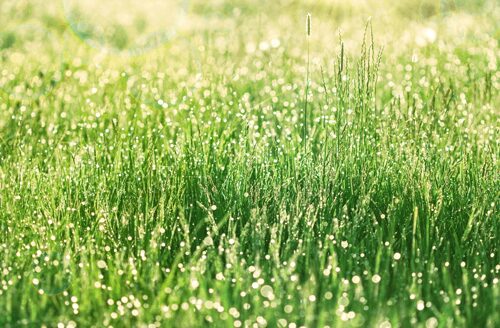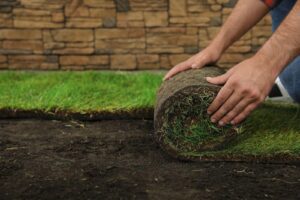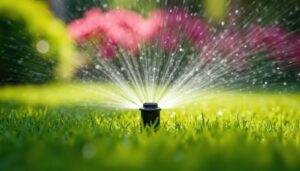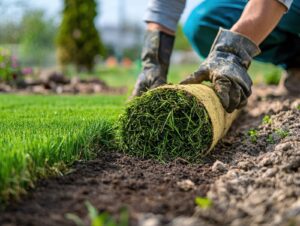UTAH LAWN SEASONAL MAINTENANCE
For a beautiful and healthy lawn that flourishes in the summer and fall, it’s vital to care for it year-round. It may be gray and cold out there now, but before long, spring will arrive, and your lawn will also spring back—hopefully, green and lush.
See what lawn care tips you can implement to ensure a healthy lawn.
UTAH LAWN TYPE
In Northern Utah, we are considered as a Region 1 lawn type (cool-season grasses), meaning our temperatures hover between 65-75 degrees during the majority of the growing season. Cool-season grasses include the two we have here: Kentucky Bluegrass and a blend of Bermuda grasses. They thrive in humid and cool arid areas of the country, so knowing your lawn type is essential for proper maintenance.
Here is a breakdown of the seasonal maintenance schedule for Utah lawns that allow for a healthy and beautiful growing season.
MAINTENANCE SCHEDULE FOR UTAH LAWNS
The cool-season lawn care schedule includes the following:
PRE-EMERGENTS – MAR-MAY, AUG-NOV
is the prime time to apply pre-emergents to your lawn. These products kill weeds before they can grow above the soil, and are important to apply before the soil reaches 55 degrees and above; this is before the seeds begin to germinate in the soil. Ensure you read the product label for mowing restrictions before and after you apply pre-emergents, so mowing doesn’t negatively impact the herbicide efficacy.
POST-EMERGENTS – MAY-OCT
is when you apply post-emergents. These products kill already-growing weeds, and there is a variety in which to choose. Take note that some will not harm foliage other than the weed you target (selective), and others will kill any plant in which it comes in contact, including your lawn. (non-selective) Again, read the product label for mowing restrictions
FERTILIZATION – MAR-NOV
is the key time to fertilize your lawn, so it has proper nutrients to thrive. There’s a balance with fertilization between relying on what your soil is giving your lawn and what you can add to it. Be aware of over-fertilizing your lawn; it can cause random spurts of growth that will look unappealing. Conversely, don’t under-fertilize, since it can result in your grass not having the ability to ward off the invasion of weeds and disease. It’s recommended to use a soil analysis test kit or taking a sample to your local cooperative extension to have it analyzed. The test can determine what nutrients your soil may be lacking. Fertilize your lawn four times a year (fall, summer, early spring, and late spring) for a healthy and hardy lawn.
MOWING – MAR-NOV
is also the time to mow your lawn. Proper mowing height and the frequency with which you mow plays a crucial role in your lawn’s overall health. Contrary to belief, cutting grass too close and short increases your maintenance load because it makes your grass susceptible to diseases and causes sunburn. In the hottest and driest times, increase the mowing height with a good rule of thumb of ⅓ the length of the grass blades at a time. To stay healthy, most grass types need between 2-3 inches in length.
Mow consistently, but note when you apply pre and post-emergent products. During spring, mow your lawn at least once weekly; in summer, you can get away with mowing every two weeks. In the fall, drop back to mowing every month until the dormant state.
WATERING – JUNE-SEPT
is the best time to water, weekly when rain levels dip below 1 inch. Keeping your lawn lush and green depends on the length of your watering as much as when you water. Proper watering can prevent several issues from taking root in your lawn. Deep, occasional waterings help to encourage deep root growth, while shallow and frequent waterings lead to shallow growth and weak roots.
Watering in the early morning is the best time to avoid scorching. Also, ensure the blades are dry before the humidity sets to prevent lawn diseases from surfacing. Water no more than 1 inch of water per session.
AERATION – MAR-APR AND SEPT-NOV (USUALLY 1-2 TIMES YEARLY)
are good times to aerate your lawn. When compacted soils inhibit growth, due to silt or clay soils or foot traffic, it can prevent air, water, and nutrients from reaching the roots. This can lead to pests and extra maintenance, including making it harder for grass to fend off weeds and recover from the damage.
Core aeration is key here, which means cores of the earth are removed, leaving holes, and then left on your lawn for extra nutrients to be later filled in with new grass.
DETHATCHING – MAR- APR (ONCE A YEAR)
helps to remove excess thatch, an excessive growth of grass that builds up before existing plant matter can decompose. It creates a barrier to air, water, and nutrients to the soil, as well as prevents pesticide or fertilizers from penetrating, thus harboring fungus, insects, and disease-causing bacteria.
Dethatching usually involves power raking or using a verticutting machine to remove the excess thatch; however, aeration can accomplish a similar result. Ensure you apply any pre-emergent after dethatching.
CONTACT MONARCH SOD
If you’re planning on installing new sod this spring, give us a call. We can schedule a prime time to deliver your sod and install it for a beautiful, green lawn this year.
var /*99586587347*/ toto slot











